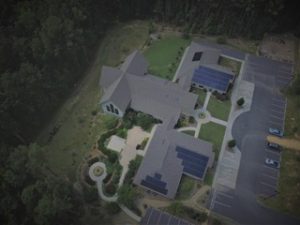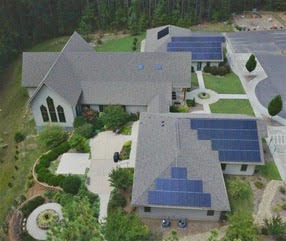See How Chapel in the Pines Presbyterian Church Is Reducing Carbon Emissions and Saving Money
By converting to solar power, we are making a difference to the environment every day. By noon on August 9, 2019, we avoided producing 2.3 metric tons of carbon dioxide. That is the equivalent of:
- Burning 2,500 lbs. of coal
- Driving 5,600 miles in an average passenger car
- Consuming 257 gallons of gas
- Burning 5.3 barrels of oil
- The amount sequestered by 38 tree seedlings grown for 10 years.
To monitor the church’s energy production and carbon avoidance, CLICK HERE.
Discover what our energy conversion means to the environment:
1 Megawatt = 1,000 Kilowatts

How it Works
Our new solar panel system replaces the electricity we previously purchased from Duke Energy Progress with clean energy that produces almost no carbon emissions (greenhouse gases). This supports our Earth Care stewardship initiative.
When we make more than we need, it is pushed out to the energy grid. When we need more electricity than we produce, Duke Energy Progress provides it to us and charges it against the surplus of energy that we don’t use. We expect a zero balance at the end of the year. Our agreement does not allow us to profit from any excess energy that we produce.

The Cost and Savings Equation
Our system cost $68,200, of which Duke Energy Progress is paying $22,500—33%! The balance is financed through a 10 year loan for $45,700 at an interest rate of 2.75% from a Presbyterian Investment and Loan Program (PILP) lending program called Restoring Creations Loan, created for churches to improve their sustainability. The system should function for 30 years, providing us with 20 years of free electricity after the loan is paid off. We should fully cover our electricity costs and provide a surplus. The church spends on average $640/month on electricity. Our loan is about $420 each month, giving us an estimated $220 of savings left over.
Highlights:
- 110 solar panels installed
- 48,000 kilowatt hours annually produced – see what it converts to!
- $640 / month saved, $7,680 annually saved
#-#-#


